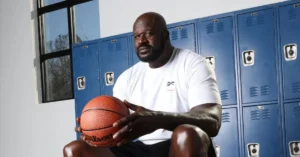NBA athletes exhibit a diverse array of physical statures and skills, demonstrating their broad athleticism and talent on the basketball court.
Among these athletes, you’ll find some of the heaviest NBA players who have defied the odds and made a name for themselves in the league. Their size and strength often give them a unique advantage over their opponents.
Top Heaviest Players in NBA History
Shaquille O’Neal is a household name in the NBA, having a successful career that solidified him as one of the heaviest players in the league. Weighing around 325 pounds, “Shaq” was a dominant force on the court.
Some things you just can’t question. Like you can’t question why two plus two is four. So don’t question it, don’t try to look it up. I don’t know who made it, all I know is it was put in my head that two plus two is four. So certain things happen. Why does it rain? Why am I so sexy? I don’t know.
Shaquille O’Neal
Nikola Jokic, the talented Denver Nuggets center, has become a force in today’s NBA. Weighing around 284 pounds, Jokic has already made it to the list of heaviest players in the league.
Zion Williamson is another modern player known for his size and skill. Weighing around 284 pounds, Williamson’s strength and athleticism has made him a standout player since his rookie season.
In NBA history, some of the heaviest players include Jusuf Nurkic, Robert Traylor, Kevin Duckworth, Eddy Curry, and Oliver Miller. These players weighed anywhere between 280 and 375 pounds during their careers, showcasing their impressive size on the court.
Today’s NBA is no stranger to massive players, as evidenced by the likes of Boban Marjanovic and Tacko Fall. Marjanovic, who weighs around 290 pounds, has become a fan favorite due to his size and enthusiastic personality. Fall, weighing approximately 311 pounds, stands at a remarkable 7 feet 5 inches tall, making him one of the tallest and heaviest players in the league.
Some of the notable players who are not far behind in terms of size include Brook Lopez, Robin Lopez, Joel Embiid, and Andre Drummond. All of these players are essential contributors to their respective teams, making them some of the heaviest players in today’s NBA.
Finally, players like Priest Lauderdale, Thomas Hamilton, and Sim Bhullar have also earned their spots in the heaviest NBA players’ echelon. These players surpassed the 300-pound mark, exhibiting their immense size and strength during their time in the league.
NBA Teams and Their Heaviest Players
Dallas Mavericks
Boban Marjanovic is the heaviest player on the Dallas Mavericks, standing at 7’4″ and weighing around 290 lbs. His size contributes to his incredible rebounding and shot-blocking abilities.
Denver Nuggets
Nikola Jokic, the 2020-2021 NBA MVP, weighs in at 284 pounds and stands 6’11”. His size and strength have played a significant role in his success as one of the league’s best centers.
New Orleans Pelicans
Zion Williamson, the 2019 first overall draft pick, weighs around 284 lbs and stands 6’6″. With his combination of skill and power, he has already made a tremendous impact in the league.
Portland Trail Blazers
Jusuf Nurkic, the center for the Portland Trail Blazers, is the heaviest player on the team, weighing 290 lbs and standing at 7’0″.
Chicago Bulls
The heaviest player on the Chicago Bulls is Cristiano Felício, weighing around 265 lbs and standing 6’10”.
Boston Celtics
For the Boston Celtics, Enes Kanter, who weighs 250 lbs and stands 6’10”, takes the position of the heaviest player on the team.
New York Knicks
The heaviest player on the New York Knicks is Julius Randle, weighing around 250 lbs and standing at 6’9″.
Milwaukee Bucks
Brook Lopez, standing at 7’0″ and weighing 280 lbs, is the heaviest player on the Milwaukee Bucks roster.
Cleveland Cavaliers
Andre Drummond, who stands at 6’10” and weighs approximately 280 lbs, holds the spot for the heaviest player on the Cleveland Cavaliers.
Miami Heat
The Miami Heat’s heaviest player is Bam Adebayo, weighing around 255 lbs and standing at 6’9″.
Role of a Player’s Size in the Game
Height is a significant factor in basketball, as taller players have a distinct advantage when reaching for rebounds. The higher you can jump, the more likely you are to secure the ball before your opponents.
This is especially true for centers, who are often responsible for cleaning up the glass and dominating the paint. For example, players like Tacko Fall, who stands at an impressive 7’5″ and 311 pounds, can be a force to be reckoned with on both ends of the court due to his size.
However, size isn’t everything. Basketball players need to be agile and quick on their feet, which is where athleticism comes into play. For instance, a tall player might have a more challenging time pulling off quick assists or covering smaller and faster opponents on the court. On the other hand, smaller players generally excel in speed and maneuverability, often having the ability to make quick moves and navigate through defenses more efficiently.
Another essential aspect to consider is the player’s overall skill set. It’s impossible to ignore that many NBA superstars have won MVP awards and dominated the league despite not being the tallest or the heaviest players. Offense is a crucial aspect of the game, and even though size can be beneficial, it doesn’t guarantee success in every situation.
The Physical Challenge and Health Risks

Injuries are a significant concern for heavy NBA players. Due to increased body mass and more force exerted during games, the risk of experiencing injuries such as sprains, fractures, and muscle strains may be higher. Furthermore, the recovery time for these athletes tends to be longer as their bodies need to cope with the additional weight. Epidemiology and injury trends in the National Basketball Association studies have shown a rise in missed games and unique injuries over time.
Heavy players also tend to put more pressure on their joints, which may result in mobility issues over time. This can lead to a decline in performance and an increased risk of chronic conditions such as arthritis.
One serious health risk faced by heavier players is cardiac arrest. The strain on the heart due to carrying extra weight may lead to complications, making the involvement of sports cardiologists paramount during the offseason and regular checkups. Regular monitoring of players’ heart health can detect problems early, helping prevent life-threatening situations.
Strength training is crucial for these players, as it helps maintain muscle mass, reduce injury risks, and improve overall fitness levels. However, excessive focus on building muscle can lead to an imbalance in the athlete’s body, potentially causing further issues. Therefore, it’s essential to have well-rounded strength programs that address the whole body in a balanced manner.
Offseason provides a significant opportunity to address some of the health risks and physical challenges faced by the heaviest NBA players. A well-planned offseason program can include strength training, cardiovascular conditioning, mobility exercises, and even dietary interventions to improve overall fitness and minimize potential health issues.
Media Perception and Fan Reactions
In recent years, the heaviest NBA players have captured the attention of both the media and fans alike. With impressive athleticism and massive size, these players have become a hot topic of discussion during the NBA season. Let’s dive into how the media perceives these athletes and how fans react to them.
Media outlets often highlight the exceptional skills of heavier NBA players, emphasizing their ability to compete at the highest level while carrying additional weight. Players like Zion Williamson and Nikola Jokic have been featured in the headlines for their impressive performances on the court, proving that being one of the heaviest NBA players does not limit their abilities.

My Personal Opinion
In my opinion, the heaviest NBA players have often brought a distinct presence to the game that’s hard to ignore. While basketball is frequently associated with agility and speed, these big men bring a different dynamic to the court. Their size commands attention and adds a unique strategy to the team’s playstyle.
Watching these players maneuver on the court can be both impressive and entertaining. How they utilize their size to dominate the paint, set screens, and even contribute to rebounds can be game-changing. It’s fascinating to see how their sheer mass can create mismatches and force opponents to adjust their strategies.
FAQ
How much do NBA players weigh?
The average weight of an NBA Basketball Player is 216.52 pounds.
How are NBA players so fit?
To stay in explosive playing shape, NBA players focus on a head-to-toe fitness regimen—muscular strength, cardiovascular strength, and using a full range of motion—when they’re training off the court, according to Gunnar Peterson, a professional trainer and strength coach for the L.A. Lakers.
What is Shaq’s max bench press?
In an interview, Shaq was asked about the highest he could bench press. To this Shaq replied: “My max was 475.” It is noteworthy that ‘The Terminator’s career max bench press record was 525.
If you liked this blog article about the topic: Heaviest NBA Players, don’t forget to leave us a comment down below to tell us about your experience.






